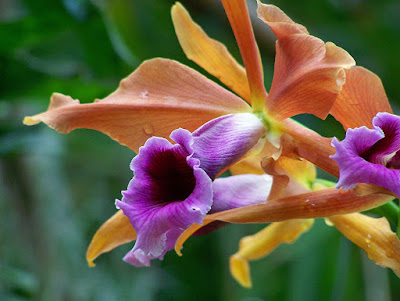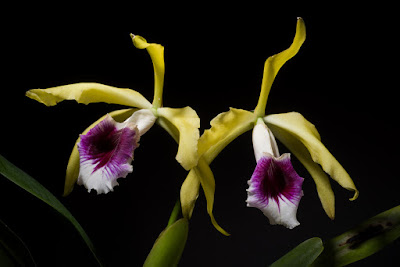Cattleya tenebrosa is native to Brazil. Their natural habitat is basically an area from Bahia in the south, after Espírito Santo in the north, where these plants grow on large trees in a dense forest...
Cattleya tenebrosa also called as The Dark Cattleya, Brasilaelia tenebrosa, Laelia tenebrosa, Chironiella tenebrosa, Hadrolaelia tenebrosa, Laelia grandis var. tenebrosa, Laelia tenebrosa var. pittiana, Sophronitis tenebrosa, is a species of the genus Cattleya. This species was described by A.A.Chadwick in 2006.
IDENTIFY CATTLEYA TENEBROSA
Cattleya tenebrosa is native to Brazil. Their natural habitat is basically an area from Bahia in the south, after Espírito Santo in the north, where these plants grow on large trees in a dense forest. This limited natural habitat has been completely destroyed and that this plant, always rarely occurring, is now virtually impossible to find in nature.
It is a medium sized, hot to cool growing species, which reaching a height of 46 cm, with a clavate, up to 18 cm long and up to 3 cm wide pseudobulb carrying a single, apical, erect, oblong-ovate to ligulate, leathery, rounded apically, 28 cm long and 6 cm wide leaf.
The Dark Cattleya has a 30 cm long, racemose inflorescence arising through a large, basal sheath and carrying 3 to 4, fragrant, short-lived, color variable flowers which occur from June through August. The flowers are often 18 cm wide. Narrow, brown or copper-colored petals of the outer and inner whorls, sometimes slightly twisted, are almost flat with slightly wavy edges, especially in the inner whorl. The tripartite lip has large lateral plots, which, when curled up, form a tube around the prone. The resulting large, trumpet-shaped lip has a dark purple ring at the base of the bright central plot, with the edge tinted brighter towards the wavy, curled top. The throat is yellow, with considerable veins that extend across the surface to the lip of the lip. In cultivation, several color varieties meet, including the form of alba with green petals of whorls and white lip.
CATTLEYA TENEBROSA CARE AND CULTURE
Cultural information should only be used as a guide, and should be to be adapted to suit you. Your physical location; where you grow your plants, how much time you have to devote to their care, and many other factors, will need to be taken into account. Only then can you decide on the cultural methods that best suit you and your plants.
Light:
Cattleya tenebrosa needs a light level of 35000-40000 lux. A large amount of light is essential to initiate flowering, but avoid the full sun. If the plants do not flower because of insufficient light, the dose should be increased gradually to give the plant time to adapt. Strong air movement should be ensured all the time.
Temperature:
It is a thermophilic plant. In summer, the average day temperature is 26-28 °C, at 20 °C at night, which gives a daily 7-8 °C difference. The average temperature is in the winter day 22-23 ° C and night 16 ° C , giving a daily difference of the order of 7 ° C .
Humidity:
The Dark Cattleya needs the humidity of about 85% throughout the year.
Substrate, growing media and repotting:
You can use small pots or baskets filled with a very thick, loose, fast-drying substrate that allows the roots to dry quickly after watering. It is recommended to use smaller pots sufficient for 1-2 years growth, because the substrate in larger pots stays wet for too long after watering. If the roots do not dry quickly after watering, it may cause rot. You can use pine bark with high gradation in plastic or ceramic pots, or ceramic pots and clay balls, for example, expanded clay.
These plants grow well also mounted on pieces of tree ferns or cork, but in the summer it requires high humidity and daily watering. In the period of extremely hot and dry weather, attached plants may require even several waterings during the day. Repotting or dividing plants should be done when the growth of new roots begins.
Watering:
For most of the year rainfall is moderate and even large, with a 3-month rather dry period, but the average rainfall may be slightly higher if the habitat is located at a higher altitude. The cultivated plants should be watered strongly during the full growth, but the roots must always dry quickly after watering. The amount of water should be slightly reduced when new increments reach maturity in the autumn.
Fertilizer:
During the active growth, the plants should be fertilized every week 1/4-1/2 of the recommended dose of fertilizer for orchids. A fertilizer with a high nitrogen content is beneficial from spring to mid-summer, and a phosphorus-rich fertilizer can be used in late summer and autumn.
Rest period:
Cattleya tenebrosa need less water in the winter, especially if they grow under the conditions of a dark, short day that occurs in moderate latitudes. However, these plants should never be dried. Fertilization should be reduced or completely eliminated until more intense watering starts in the spring.















COMMENTS